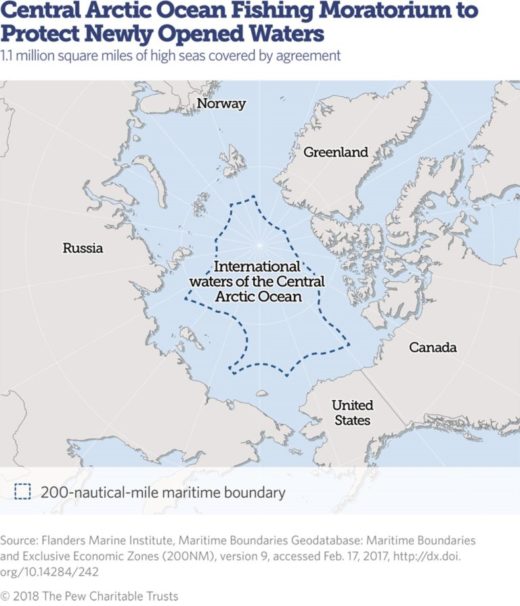- Nine jurisdictions — Canada, Norway, Russia, the U.S., China, Iceland, Japan, South Korea, Denmark (including Greenland and the Faroe Islands) and the European Union — have signed a legally binding agreement that bans commercial fishing in the high seas portion of the Central Arctic Ocean, covering 2.8 million square kilometers, or an area about the size of the Mediterranean Sea, for at least 16 years.
- As part of the agreement, the signatory parties have committed to a joint scientific research and monitoring program to gain a better understanding of the changing Arctic ecosystem and determine the region’s potential for commercial, sustainable fisheries in the future.
- The moratorium will initially cover 16 years, but this can be extended in five-year increments, if the parties agree to do so.
With the Arctic’s melting ice cover leaving the ocean ice-free for longer periods of time, new shipping routes are opening up, paving the way for future commercial activities. But under a new agreement, commercial fishing will be banned across a large chunk of the Central Arctic Ocean as a precautionary measure for at least 16 years from when it comes into force.
After several years of negotiations, nine jurisdictions — Canada, Norway, Russia, the United States, China, Iceland, Japan, South Korea, Denmark (including Greenland and the Faroe Islands) and the European Union — signed the legally binding “Agreement to Prevent Unregulated High Seas Fisheries in the Central Arctic Ocean” in Ilulissat, Greenland, on Oct. 3.
While no fishing takes place in the Central Arctic Ocean at the moment, rising temperatures and melting ice could make this a possibility soon. The agreement bans commercial fishing in the high seas portion of the Central Arctic Ocean, covering 2.8 million square kilometers (1.1 square miles), or an area about the size of the Mediterranean Sea, until there’s a better scientific understanding of the fish stock in the region.
As part of the agreement, the signatory parties have agreed to a 16-year moratorium and committed to a joint scientific research and monitoring program to gain a better understanding of the changing Arctic ecosystem and determine the region’s potential for commercial, sustainable fisheries in the future. The moratorium will initially cover 16 years, but this can be extended in five-year increments, if the parties agree to do so.
“During that time, the region will be protected from unregulated fishing while scientists and policymakers develop the structures and controls that would be necessary to ensure that any fishery is ecologically sustainable,” Steve Ganey, senior director for lands and ocean programs at the U.S.-based nonprofit Pew Charitable Trusts, said in a statement.
The five countries bordering the high seas area — the U.S., Canada, Denmark, Norway and Russia — see the agreement primarily as a means to ensure that no high seas fishing undermines the security of natural resources under their jurisdiction, Ganey said. “And for the countries outside the Arctic region, I think they are looking into the future and anticipating that there will someday, at least potentially, be a commercial fishery,” he said. “By signing on to this agreement now, it guarantees them a seat at the table when a new agreement may be negotiated that could authorize commercial fishing on a sustainable basis.”

The Inuit Circumpolar Council, which represents Inuit from Canada, Alaska, Greenland and the Russian region of Chukotka, are a part of the agreement.
“The shrinking ice cover is affecting the traditional lifestyles of the Indigenous peoples of Canada’s North, a fact emphasized by Inuit Circumpolar Council during the negotiation of this Agreement,” the Canadian government said in a statement. “Indigenous peoples will continue to play an integral role in the implementation of this Agreement and their traditional knowledge will be an important source of information moving forward. Territorial governments, the fishing industry, and environmental groups will also be involved.”
Denmark’s minister for fisheries, Eva Kjer Hansen said in a statement that this was the first time a fisheries agreement was in place for such a large area even before fishing had begun.
“This is historical,” Hansen said. “Amongst other things, it is important that a joint program of scientific research and monitoring will be established in order to secure a solid scientific basis for sustainable fisheries.”
